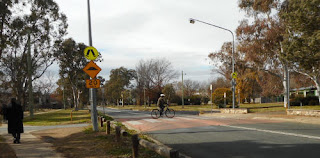Pedestrians and Cycling ALGA NGA 2019, ACT Crossing and mysterious markings
 | ||
 Pedestrian/Cyclist Crossing David St, O'Connor ACT (16Jun 2019) Pedestrian/Cyclist Crossing David St, O'Connor ACT (16Jun 2019) |   |
 |
| Wombat Crossing, Norton St, Leichhardt |
Note:
20kmph advisory speed limit for the "speed hump"
Slowdown advisory speed on shared path approaching crossing.
Profile and Colouring of "pedestrian crossing". It is not an at grade crossing nor is it a wombat crossing (in markings or profile)
ALGA NGA 2019 Motions
14 (Resolved): Hobart Council, TAS
 |
Mysterious Sign - O'Connor Shops |
Objective:
An infrastructure fund for the construction of active transport initiatives including pedestrian and bicycle facilities will lead to increased physical activities, decreased congestion and decreased emissions.Key Arguments:
Cities are increasingly focusing on the need for active travel with the infrastructure required to support the implementation of these policies is expensive and usually prohibits cities from investing in these transport options.A National Active Transport Fund is needed to provide matched funding to cities for active travel infrastructure projects. A new Active Transport Strategy should be established alongside this fund to outline the strategic objectives of the fund and provide a national plan for prioritisation of projects.
16 (Resolved): Town of Cottesloe, WA
That this National General Assembly calls on the Australian Government to develop a policy on the traffic speeds in urban Australia to meet the needs of current and future Australians based on national and international evidence regarding safety, amenity, illness prevention and sustainability.That the policy statement be used to progress speed reform in urban Australia at a Federal and State level.
Objective:
There were an estimated 1143 deaths due to road trauma in 2018. That is 1143 too many. Speed has a direct impact on the risk and severity of road trauma https://www.itf-oecd.org/sites/default/files/docs/speed-crash-risk.pdfThis a national objective because road trauma impacts every town and city.
It is a national objective because creating an environment where most people can feel safe to walk and ride a bike will have a major impact on the diabetes and obesity epidemic that is facing Australia It is an national objective because it will assist Australia to meet its emissions targets. Lowered emissions will further improve the health of Australians living in urban environments.
Key Arguments:
Lowering speed on residential streets is the future of our cities. It saves lives in the short term. 90% of people hit by a car at 50km/hr die or are severely injured, 75% of people hit by a car at 30km/hr survive. (Austroads research report AP-R498-15)It saves lives in the long term. Lower speeds on our streets get students on bikes to school and uni. It gets Mums and Dads walking to public transport and biking to work. Every street becomes a street for people as well as cars. Obesity prevented.
Mental health improved. Diabetes and cancer lessened. There is a wealth of international and some local evidence demonstrating these benefits.
The current ALGA position in relation to travel speeds on local roads misses the opportunity to address the benefits of widespread speed reform (page 25 of the 2019 Local Government Roads and Transport Agenda https://cdn.alga.asn.au/wp-content/uploads/ALGA-2019-Local-Government-Roads-and-Transport-Agenda.pdf ). It states that the ALGA is seeking locally targeted action for “safer pedestrians and cyclists, through speed management and provision of appropriate safety measures such as grade separated paths, pedestrian crossings, clear sight lines”
Recommendation 8 from the 2018 Inquiry into the National Road Safety Strategy is to “Accelerate the adoption of speed management initiatives that support harm elimination” https://roadsafety.gov.au/nrss/files/NRSS_Inquiry_Factsheet_September_2018.pdf
The most effective way to accelerate speed management initiatives is through speed reform.
The development of this policy by the Australian Local Government Association is an important step in beginning a coordinated strategic approach to speed reform at a federal and state level. Change occurring road by road, council by council will not achieve the system wide improvements needed to turn around our looming health crisis.
What benefits do we get from speed reform? Our amenity improves along with health and safety. Noise lessens. We meet our neighbours. Travel times by car remain comparable. Emissions lessen. It’s affordable, it’s within our reach. It aligns with the objectives of the National Road Safety Strategy. Doing this is an important and necessary step to be “Future Focused” – if we want our children’s future to be a brighter one.



Comments
Post a Comment